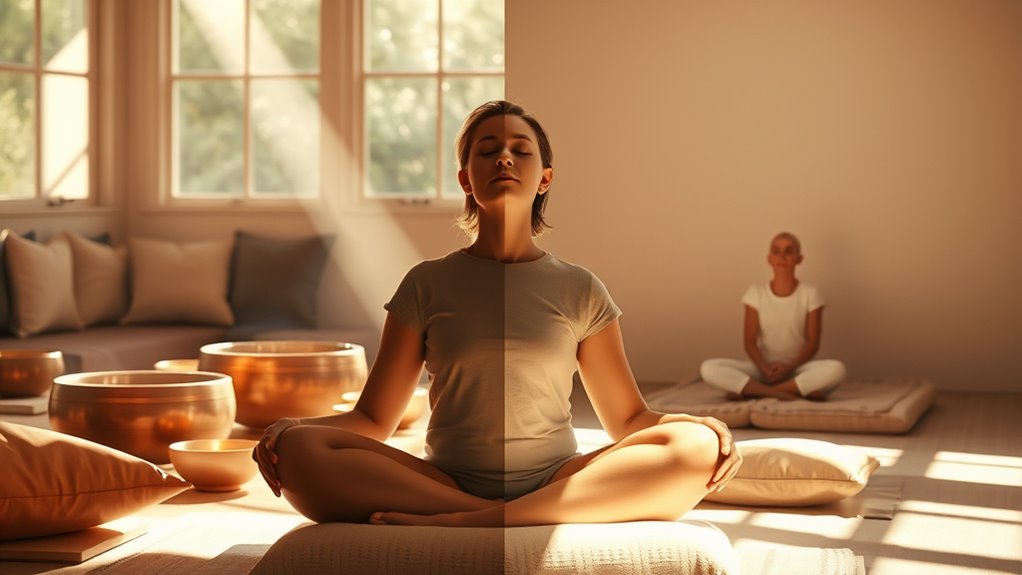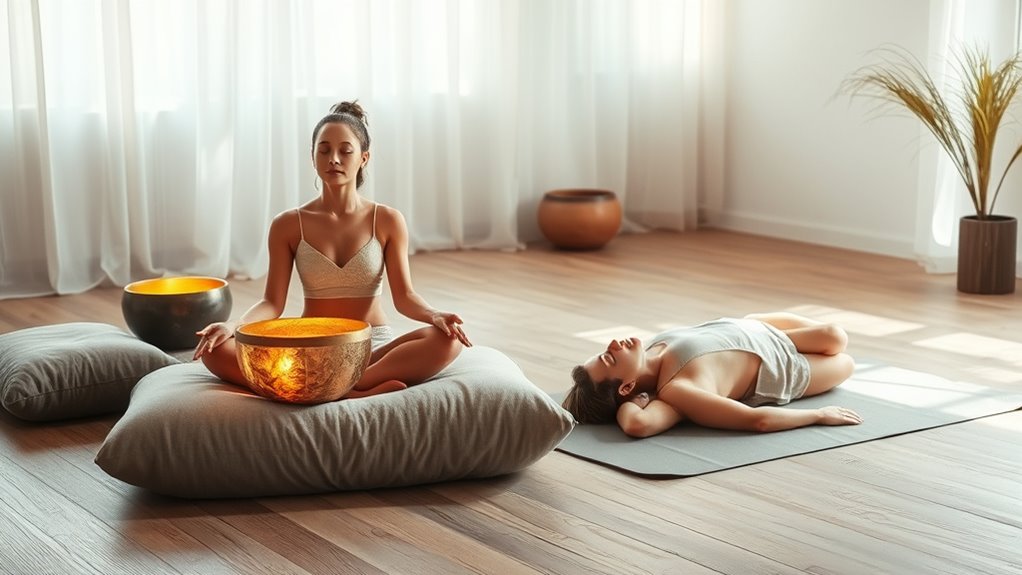If you’re seeking quick stress relief, a sound bath might be your best choice, as its vibrational sounds provide immediate sensory immersion and promote relaxation through external cues. On the other hand, a silent retreat offers deep, lasting healing by guiding you into internal mindfulness and awareness over time. Both help you heal, but your preference for fast relief or profound, long-term growth will influence which is right for you. Keep exploring to discover more about these calming paths.
Key Takeaways
- Sound baths may provide quicker relief through multisensory stimulation and external sound cues that accelerate relaxation.
- Silent retreats tend to offer more gradual, profound healing by fostering deep internal awareness over time.
- External auditory stimuli in sound baths can quickly release tension, while silent retreats cultivate long-term resilience.
- The speed of healing depends on individual needs: quick stress relief with sound baths versus sustained internal growth with silent retreats.
- Both methods contribute to healing, but sound baths generally facilitate faster immediate relaxation, whereas silent retreats promote lasting transformation.

When it comes to finding inner peace and mental clarity, both sound baths and silent retreats offer unique paths, but understanding their differences can help you choose the right experience. If you’re exploring methods to heal faster or deepen your mindfulness practice, it’s essential to understand how each approach engages your senses and employs meditation techniques to foster relaxation.
Sound baths primarily use sound vibrations produced by gongs, bowls, and tuning forks to guide your mind into a meditative state. During a session, you lie down comfortably as these sounds wash over you, creating rich sensory experiences that help release tension and promote mental clarity. The auditory stimuli serve as a form of meditation technique that encourages focus and mindfulness, making it easier to disconnect from everyday stressors. The immersive nature of sound baths stimulates your auditory senses, and many people find this multisensory engagement accelerates their sense of calm and healing. Because the vibrations resonate through your body, they can also promote physical relaxation and emotional release, often leading to faster feelings of well-being.
Sound vibrations from gongs, bowls, and tuning forks promote relaxation, mental clarity, and emotional release through immersive auditory experiences.
In contrast, silent retreats emphasize solitude and minimal external stimuli. You spend extended periods in silence, often in a natural setting or a dedicated retreat space, with the goal of deepening your internal awareness. The meditation techniques used here typically involve silent sitting, walking, or mindful observation, fostering a heightened sense of presence. Without external distractions, your sensory experiences become sharper, allowing you to notice subtle thoughts and bodily sensations more clearly. This intense focus on internal states helps you develop resilience against mental clutter, which can lead to profound insights and gradual healing. Since silent retreats require you to sit with your thoughts without external interruption, the healing process tends to be more gradual but deeply rooted in self-awareness. Additionally, high-quality projectors can enhance your experience in a home cinema setup, but it’s crucial to match projector features with your specific needs for optimal results.
Ultimately, the speed of healing depends on your individual needs and preferences. If you’re seeking quick relief through sensory stimulation and external sound cues, a sound bath might be more effective. But if you prefer a long-term, introspective approach that cultivates resilience and clarity, a silent retreat could be more beneficial. Both methods can foster significant healing, but their distinct meditation techniques and sensory experiences cater to different styles of mindfulness. Recognizing which resonates with you will help you choose the path that accelerates your journey toward inner peace and mental health.
Frequently Asked Questions
Can Sound Baths Replace Traditional Therapy?
You might wonder if sound therapy can replace traditional therapy, but it’s essential to understand their roles. Sound baths promote emotional release and relaxation, helping you manage stress and anxiety. However, they don’t address deep-rooted issues or provide tailored guidance like traditional therapy. While sound therapy can complement your healing process, it shouldn’t fully replace professional mental health treatment, especially for complex emotional or psychological challenges.
Are Silent Retreats Suitable for Beginners?
Imagine stepping into a silent retreat and feeling like you’ve entered a whole new universe! For beginners, silent retreats are incredibly suitable because they offer a profound exploration into mindfulness practices and relaxation techniques. You won’t need prior experience—just an open mind. With guided meditations and peaceful surroundings, you’ll gradually uncover calmness and clarity, making silent retreats the perfect starting point for anyone enthusiastic to explore inner peace and mental wellness.
How Long Does It Take to See Results?
You might start noticing mindfulness benefits and emotional release within a few days to weeks of consistent practice. The timeline varies based on your commitment and openness. Regularly engaging in meditation or sensory experiences helps accelerate healing, allowing you to experience clarity and emotional relief sooner. Stay patient and dedicated—your mind and body will respond over time, revealing deeper states of calm and emotional balance.
Are There Any Risks Involved in Sound Baths?
You might wonder about risks involved in sound baths. While generally safe, risk factors like pre-existing mental health issues or hearing sensitivities could cause discomfort. To guarantee safety, follow recommended safety precautions: choose reputable practitioners, communicate your health concerns beforehand, and avoid sound baths if you’re pregnant or have ear conditions. Staying informed and listening to your body helps prevent potential issues, making your experience both safe and beneficial.
Which Option Is More Cost-Effective Long-Term?
When considering your wellness options, think about which is more cost-effective long-term. Affordable options like regular sound baths or silent retreats can lead to long-term savings by reducing healthcare costs and stress-related expenses. If you prioritize ongoing mental and physical health, investing in these practices now can pay off over time, making them smart, budget-friendly choices for sustained well-being.
Conclusion
Whether you choose a sound bath or a silent retreat, you might find that the healing happens when you least expect it. Sometimes, a simple coincidence—a moment of clarity during a session—can uncover deeper relaxation. The key is to stay open and listen to what your mind and body need. After all, the fastest healing often comes when you least plan for it, turning everyday moments into powerful breakthroughs.









